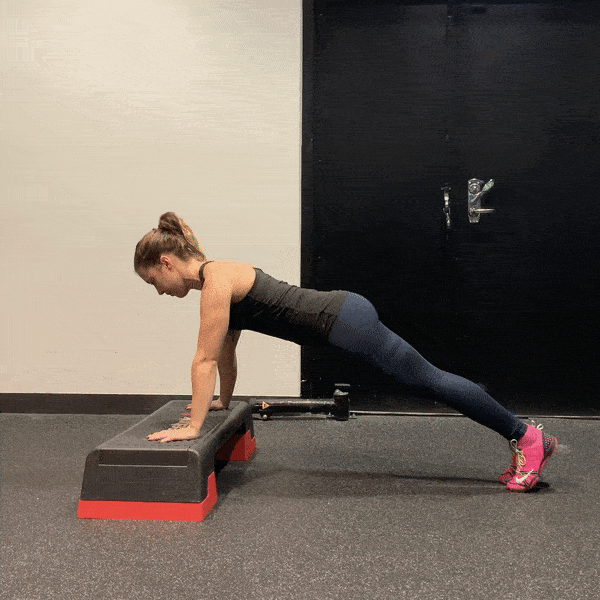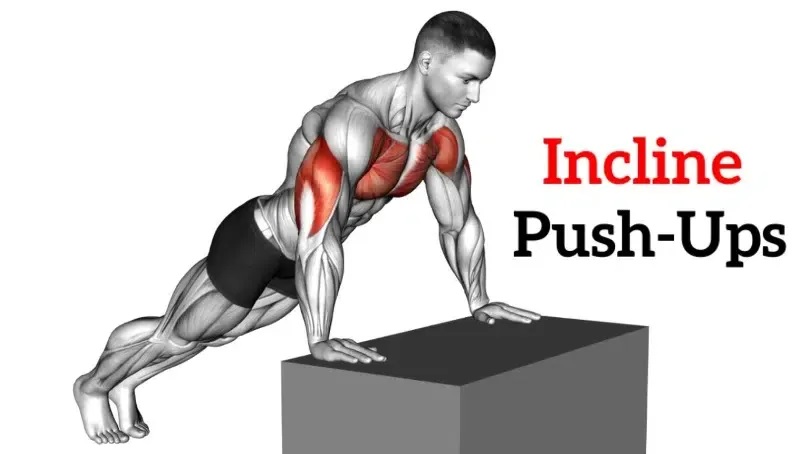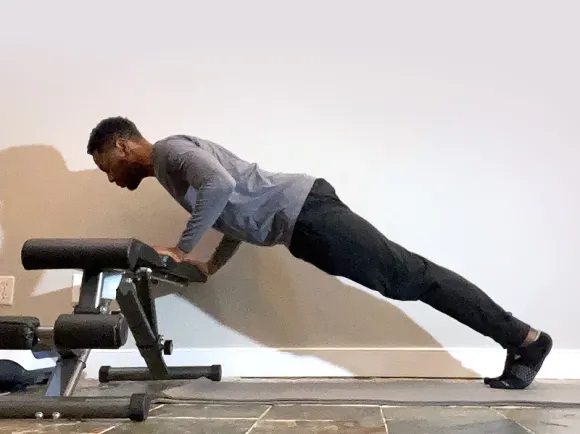Incline push up is a modified version of the traditional push up that offers numerous benefits for individuals of varying fitness levels. By elevating the upper body, this exercise reduces the intensity and strain on the joints while still effectively targeting the muscles of the chest, shoulders, and arms. This incline version of push up provides a versatile and accessible option for strengthening the upper body, engaging the core muscles, and improving overall fitness. Whether you’re a beginner looking to build strength & muscle or an experienced athlete seeking a joint-friendly variation, incline push up can be an excellent addition to your workout routine.
Don’t Miss: Best Exercises for Chest (Big, Defined & Muscular!)

Just like standard push up, incline push up also needs almost no equipment so you don’t necessarily need to go to the gym to perform it. All you need is an elevated surface such as a bench, steps, box etc. Without further ado, let’s know how to perform this exercise with perfect form safely, what benefits we will get from doing this movement and what are the variations to make it more challenging and beneficial for strength and muscle building.
How to Perform Incline Push Up?
Let us remind you that as with any exercise, it’s essential to maintain proper form and gradually progress the difficulty level to avoid strain or injury. So, let’s not waste more time and learn this step-by-step guide on how to perform incline push up perfectly with proper form safely.
Step 1: Find an Incline Surface
Locate a sturdy surface that is elevated above the ground, such as a bench, step, or elevated platform. Make sure the surface is stable and can support your body weight.
Step 2: Position Yourself
Stand facing the incline surface and place your hands slightly wider than shoulder-width apart on the surface. Your palms should be facing down, and your fingers should be pointing forward.
Step 3: Assume the Starting Position
Step back and extend your legs behind you, keeping your feet together. Your body should form a straight line from your head to your heels. This is the starting position for the incline push up.
Step 4: Lower Your Body
Bend your elbows and slowly lower your chest towards the incline surface while maintaining a straight body alignment. Keep your core engaged, and avoid allowing your hips to sag or your lower back to arch excessively.
Step 5: Push Back Up
Once your chest is close to or lightly touches the incline surface, push through your palms and extend your arms to raise your body back up to the starting position. Exhale as you push yourself up.
Step 6: Repeat with Proper Form
Continue performing the exercise up by repeating steps 4 and 5 for your desired number of repetitions. So, we have explained how to perform this exercise properly and now it’s up to you to try your best to maintain proper form throughout the exercise to maximize the results and minimize the chances of injuries.

Tips!
– Keep your neck in a neutral position, looking slightly forward.
– Engage your core muscles while performing the exercise to maintain stability.
– Breathe in as you lower your body and exhale as you push back up.
– Start with a comfortable incline level, and gradually increase the difficulty by using a lower surface or adjusting your hand position.
Don’t Miss: Best Bodyweight Exercises to Gain Muscle for Beginners!
Benefits of Incline Push Up
Incline push up offers several benefits for individuals of different fitness levels. Here are some of the key advantages of including this exercise in your workout routine.

Upper Body Strength
This variation of push up primarily targets the muscles of the chest aka the pectoral muscles especially the lower pecs/chest, shoulders aka deltoids, and triceps. By performing it, you can effectively strengthen and tone these muscles, leading to improved upper body strength and definition.
Joint-Friendly Variation
Incline push up is a modified version of the traditional push up, making it easier on the joints, particularly the wrists and shoulders. The elevated surface reduces the amount of weight and stress placed on these joints, making it a suitable option for individuals with joint limitations or injuries.
Core Engagement
While incline push up primarily targets the upper body, it also engages the core muscles, including the abdominals and lower back. As you maintain a straight body alignment during the exercise, your core muscles work to stabilize your body, promoting overall core strength and stability.
Versatile and Accessible
This amazing bodyweight exercise can be performed using a variety of elevated surfaces, such as benches, steps, or even the edge of a sturdy table. This versatility allows you to adjust the difficulty level to suit your fitness level and you can gradually progress by using lower surfaces as you get stronger.
Improved Scapular Stability
Incline push up requires scapular stabilization that means it helps to strengthen the muscles that control the movement and stability of the shoulder blades. This can be particularly beneficial for individuals with poor posture or those recovering from shoulder injuries. So, ultimately, this excellent bodyweight exercise can improve your posture a lot.
Full Body Activation
In addition to targeting specific muscle groups, this incline version version of push up also engages other muscles, including the biceps, forearms, and upper back muscles. This compound movement also recruits multiple muscle groups, leading to a more comprehensive and effective workout.
Convenient Home Exercise
Incline push up can be performed at home or in various outdoor settings using minimal equipment. You can use everyday objects, such as stairs or furniture, to create an inclined surface, making it a convenient exercise option that requires little to no equipment.
Variations of Incline Push Up
There are several variations of this bodyweight exercise that you can incorporate into your workout routine to target different muscle groups and add variety to your training. Here are some common and most popular variations of incline push up.
High Incline Push up
In high incline push up, you use a higher elevated surface, such as a bar or Smith machine in the gym to perform the exercise. This variation reduces the intensity even further, making it suitable for beginners or individuals with limited upper body strength.
Low Incline Push up
With low incline push up, you use a lower elevated surface, such as a step or aerobic platform. This variation increases the difficulty level compared to high one thanks to the low inclined surface and it also requires more strength and stability in the upper body. And, matter of fact, if you can master it, you can also easily perform standard push ups!
Wide Grip Incline Push up
In wide grip incline push up, you place your hands wider than shoulder-width apart on the elevated surface. This variation targets the chest muscles from a different angle and puts more emphasis on the outer portion of the chest while putting lesser emphasis on the triceps.
Close Grip Incline Push up
Close grip incline push up involves placing your hands closer together on the elevated surface, just slightly wider than shoulder-width apart or even touching. This variation places greater emphasis on the triceps muscles while still targeting the chest and shoulders but slightly less.
One-Leg Incline Push up
This vitiation, as it’s name suggests, involves raising one leg off the ground while performing the push up. This variation challenges stability, activates the core muscles, and targets the upper body muscles more intensely. To be honest, it is not as easy as it looks! Among all the variations, this is the best for increasing your stability.

Alternating Incline Push up
Alternating incline push up involves performing a regular incline push up with one hand on the elevated surface while the other hand is on the ground, then switching the hand positions for the next repetition. This variation challenges stability and strengthens both sides of the upper body excellently. It is one of the best bodyweight exercises for chest or pectoral muscles and anterior deltoids if you can perform it correctly.

Single-Arm Incline Push up
Single-arm incline push up is performed with one hand on the elevated surface while the other hand is placed on the ground. This variation increases the demand on each arm individually, challenging stability and strength. It is undoubtedly one of the most challenging push up variations that if you can master is greatly beneficial to develop explosive upper body strength!
Also Read: Gain Muscle Fast with these 10 Golden Tips! (For Beginners!)
Remember to choose variations that align with your fitness level and gradually progress as you become stronger. By incorporating different incline push up variations, you can target specific muscle groups, add variety to your workouts, and continue challenging yourself for ongoing progress.
Conclusion
In conclusion, all we need to say that hopefully, you have found this article about the technique, variations and benefits of incline push up helpful enough and hopefully, all your queries regarding this great bodyweight movement have been answered. If it’s really so then don’t hesitate to express your valuable thoughts in the comment section below. Thanks for visiting and appreciating our work.
